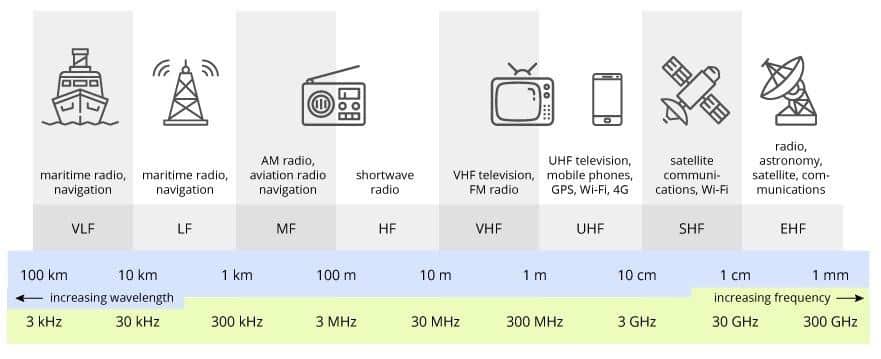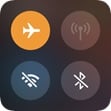Radio Frequency interference is the conduction or radiation of radio frequency energy. The radio frequency energy couples with the electrical or electronic devices and produces noise. The noise is undesirable.
Did you try before to talk to another person in a Noisy environment? For sure that would affect your conversation, you will not be able to hear another person, and finally, you will get nothing.
That is typically what happens with the electric devices also, there are many devices that used the frequency signals to send and receive data. When these signals are overlapping, definitely that would make a negative effect on the devices.
So, today we are going to speak about the (RFI) Radio Frequency Interference, its causes, its negative impacts on the equipment, and how to get rid of this problem.
How could signals transmit over frequency?
First, there is a transmitter that begins the RF communication. The transmitter takes the initial digital data and modifies the data using a modulation technique (like QPSK, QAM, etc.) to encode the data and convert that into the analog signal using DAC (digital to analog converter).
That analog signal is fed to the transmitter chain which amplifies the signal to a higher power level and then signals is fed to the antenna.
The antenna transmits that signal in the form of electromagnetic waves in the air.
On the other side, the receiver device receives the signal from the air. As there are many types of electromagnetic waves in the air, the receiver device antenna receives the signal and filter out the desired signal.
Then that signal is amplified and fed to the ADC (Analog to digital converter), which converts the analog signal to a digital signal. Then this digital signal is demodulated and information is thus decoded.

What is meant by RFI?
Interference is the effect of unwanted energy due to one or a combination of emissions, radiations, inductions upon reception in a radio communication system.
So, Radio Frequency Interference is the conduction or radiation of radio frequency energy that causes an electronic or electrical device to produce noise that typically interferes with the function of an adjacent device.
It also refers to the disruption of the normal functionality of a satellite due to the interference of radio astronomy. Radio frequency interference can disrupt and disturb the normal functioning of electronic and electrical devices, and thus it is important to limit it when possible.
Equipment and Appliances that commonly cause interference
All electrically powered equipment produces electromagnetic fields (radio waves). For most equipment, this effect is unwanted and is limited by design to comply with mandatory standards.
For other equipment (transmitters) the radiation is intentional and necessary for communication or material treatment.
Some examples of interfering equipment are listed below:
- Switch mode power supplies, TVs, stereos, DVD players, satellite receivers, videos, computers, 12-volt lighting, energy saver bulbs and other lighting equipment.
- Variable speed drives, water pumps, air conditioners, lifts.
- Motorized equipment, drills, food processors, model trains, vacuum cleaners, water blasters.
- Microprocessor controlled equipment, computers, sewing machines, alarms, TVs, DVD players, heat pumps.
- Unstable masthead or distribution amplifiers, incorrectly installed distribution hardware, and faulty receiving equipment.
How could our cell phones effect on airplanes?
One of the best examples of the RFI is what happens on airplanes when you are supposed to put your cell phone on Airplane mode. Did you ever ask yourself WHY?

Pilots claim that active cell phones could interfere with their navigation equipment but It’s never been proven that a mobile phone signal has interfered with the navigation performance of the aircraft but just because it’s never happened doesn’t mean it will never happen.
The real reason airlines in the U.S. make you put your phone on “Airplane Mode” is because of the Federal Communications Commission.
FCC regulations ban the use of cell phones on planes in order to “protect against radio interference to cell phone networks on the ground.” Meaning at 40,000 feet in the air, active cell phones would be picking up service from multiple cell towers on the ground. This could crowd the networks on the ground and disrupt service.
How to overcome the RFI?
Here are two basic strategies to control RFI. The first prevents it from coupling in the first place by using filters or arc snubbers at the source, relocating equipment or rerouting cables, using signal path ground isolators, or adding shielding or ferrite chokes to cables.
The second filters out the RF, when possible after it is coupled but before it reaches a sensitive active device in the equipment. The following recommendations can help prevent or cure most RFI problems.
- Keep cables as short as possible, and pay attention to routing. A long cable not only increases power line common-impedance coupling (for unbalanced cables), but it also makes the cable a better antenna. Routing cables close to such ground planes as metal racks or concrete floors will reduce antenna effects. Never coil excess cable length.
- Use cables with heavy gauge shields. Cables with foil and drain wire shields have much higher common-impedance coupling than those with braided copper shields, increasing power line noise coupling. Multiple shields offer no improvement unless they are connected at both ends.
- Maintain good connections. Connectors left undisturbed for long periods can develop high-contact resistance or become metal oxide detectors for RF. Humor other interference that changes when the connector is wiggled indicates a poor contact. Use a good commercial contact fluid and/or gold-plated connector.
- Install RFI filters in the signal path. If the offending RF interference is more than about 20 MHz, ferrite clamshells, which are easily installed over the outside of a cable, can be effective. In most cases, they work best when placed on the cable at or near the receive end. If this is inadequate, or the frequency is lower (such as AM radio), you can add an RFI filter on the signal line. For mic line applications, L should be a miniature toroid to prevent possible magnetic hum pickup. If FM, TV or cell phone is the only interference, a small ferrite bead may suffice for L. In any case, C should be an NP0/C0G type ceramic disc with short leads. For severe AM radio interference, C may be increased to about 1,000 pF maximum.
- Do not add unnecessary grounds. It will generally increase circulating ground noise rather than reduce it. Attempting to short out RFI with heavy ground wires is generally ineffective. At RF, a wire’s impedance is proportional to its length but nearly unaffected by its gauge. For example, 8 feet (2.4 m) of AWG #10 wire has an impedance of 22 V at 1 MHz (AM broadcast band). Using AWG #0000 wire (about 1/2 inch or 13 mm diameter) reduces it to only 18 V. Of course, never disconnect a safety ground or lightning protection ground to solve a problem-it is both illegal and dangerous.
References
If you need more detailed information about the RFI please get back to:
- citc.gov.sa
- techopedia.com
- svconline.com
- businessinsider.com
- techplayon.com
- extremenetworks.com
Read Next :